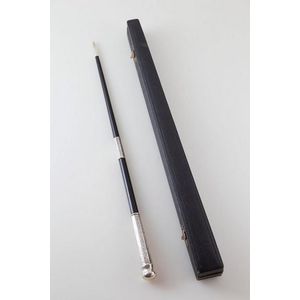Muromachi Wakizashi with Strong Hamon and Utsuri
You must be a subscriber, and be logged in to view price and dealer details.
Subscribe Now to view actual auction price for this item
When you subscribe, you have the option of setting the currency in which to display prices to $Au, $US, $NZ or Stg.
- Manner of .... / Style of ..... - A cataloguing term where the item, in the opinion of the cataloguer is a work in the style of the artist, craftsman or designer, possibly of a later period.
- Circa - A Latin term meaning 'about', often used in the antique trade to give an approximate date for the piece, usually considered to be five years on either side of the circa year. Thus, circa 1900 means the piece was made about 1900, probably between 1895 and 1905. The expression is sometimes abbreviated to c.1900.
- Shakudo - Japanese shakudo is a traditional alloy that has been used in Japan for centuries. It is primarily composed of copper and gold, with the copper serving as the base metal and the gold adding a yellowish hue to the alloy. Shakudo is known for its beautiful dark blue-black or black colour, which is achieved through the addition of a small amount of a patina-inducing element like silver or arsenic.
The word "shakudo" itself can be translated as "red copper" in Japanese, referring to the reddish-brown color of the pure copper base metal before it is patinated. The gold content in shakudo is usually around 4-10%, but this can vary depending on the specific purpose or desired appearance.
Shakudo has been traditionally used in various forms of decorative arts and crafts in Japan. It is particularly associated with metalwork, including sword fittings (such as tsuba, menuki, and kashira), jewelry, and small ornamental objects. The alloy's dark color provides a striking contrast to other metals like silver or gold, making it ideal for intricate inlay work or as a background for other decorative elements.
This item has been included into following indexes:
Visually similar items

9ct rose gold pencil holder weight including pencil stub 11.5 grams, together with pencil by Perry & Co

Sterling silver mounted ebony conductors baton in original case with presentation inscription

Japanese, Type 30 A bayonet, 1897/1935, Tokyo/Kokura arsenal mark, 15 1/2 inch fullered steel blade in grease, some staining, hook quillon with flattened spur tip,1.5 cm muzzle ring, contoured wood grips, (decay to one) oval screws, round bird head pommel,

Antique sterling silver mechanical pencil by Baker & sons, with design registration #565713
